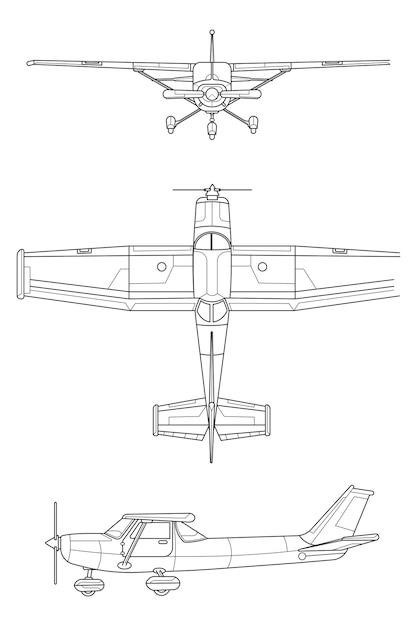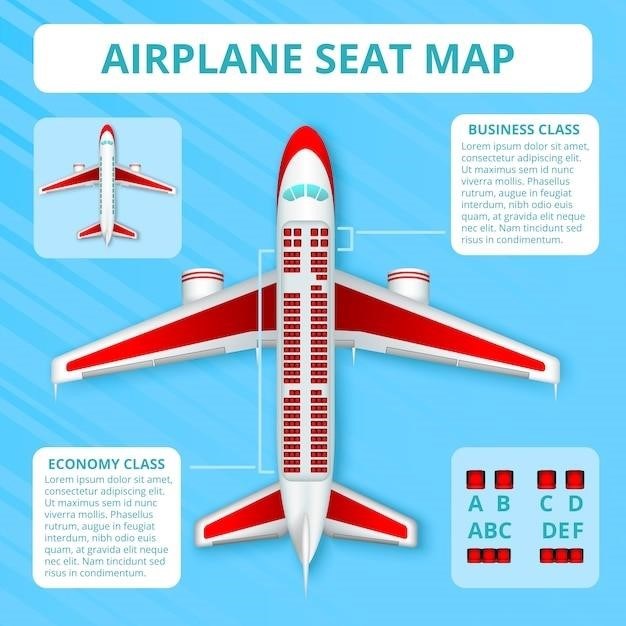Cessna 172N Parts Manual⁚ A Comprehensive Guide
This guide delves into the essential aspects of the Cessna 172N Parts Manual, a vital document for pilots, mechanics, and anyone involved in maintaining this popular aircraft. The manual provides a detailed breakdown of every component, offering essential information for troubleshooting, repair, and ensuring safe operation. The guide will explore its structure, key features, and how to utilize it effectively. Whether you’re a seasoned pilot or a novice, understanding the Cessna 172N Parts Manual is crucial for responsible aircraft ownership and maintenance.
Introduction
The Cessna 172N, a renowned single-engine aircraft, has earned its place as a staple in general aviation. Known for its reliability and versatility, the 172N has served as a platform for flight training, personal transportation, and even specialized missions. However, maintaining the integrity and safety of this aircraft necessitates a comprehensive understanding of its intricate components. This is where the Cessna 172N Parts Manual steps in, serving as the definitive guide to the aircraft’s construction, maintenance, and repair.
The Parts Manual is an indispensable resource for pilots, mechanics, and anyone involved in the upkeep of the 172N. It provides detailed illustrations, specifications, and part numbers for every component, enabling accurate identification, procurement, and installation. The manual’s purpose extends beyond mere identification; it serves as a roadmap for understanding the aircraft’s functionality, troubleshooting issues, and ensuring its continued airworthiness.
This guide will explore the intricacies of the Cessna 172N Parts Manual, delving into its structure, key features, and practical applications. We’ll examine the importance of the manual in maintaining the aircraft’s safety and performance, and provide insights on how to effectively navigate its contents. By the end, you’ll have a thorough understanding of the Parts Manual’s role in the world of Cessna 172N ownership and operation.
Understanding the Cessna 172N Parts Manual
The Cessna 172N Parts Manual is essentially a technical encyclopedia dedicated to the aircraft. It encompasses a vast collection of information, meticulously organized to provide a comprehensive understanding of the 172N’s design, construction, and maintenance requirements. The manual is not merely a list of parts; it delves into the intricate details of each component, its function, and its relationship to the overall aircraft system.
The manual’s content is presented in a clear and concise manner, utilizing detailed illustrations, schematics, and descriptive text. This approach allows for easy identification of parts, comprehension of their assembly, and understanding of their interaction within the aircraft’s complex network of systems. The manual’s extensive index and cross-referencing system make navigating its contents efficient and straightforward.
Beyond its technical aspects, the Cessna 172N Parts Manual is a vital tool for ensuring the aircraft’s airworthiness. It outlines critical maintenance procedures, inspection schedules, and repair guidelines, ensuring that the aircraft remains in a safe and operational state. By adhering to the manual’s instructions, pilots, mechanics, and aircraft owners can proactively maintain the 172N’s integrity, minimizing the risk of malfunctions and ensuring a safe flying experience.
Importance of the Parts Manual
The Cessna 172N Parts Manual plays a crucial role in maintaining the aircraft’s safety, reliability, and overall performance. It serves as a comprehensive guide for pilots, mechanics, and aircraft owners, providing essential information for a multitude of tasks, including⁚
- Troubleshooting⁚ When faced with a malfunction, the parts manual helps pinpoint the affected component, understand its function, and identify potential causes for the issue.
- Repair⁚ The manual provides detailed instructions for disassembling, repairing, and reassembling components, ensuring proper procedures are followed and preventing further damage.
- Maintenance⁚ The manual outlines scheduled maintenance tasks, including inspections, lubrication, and adjustments, ensuring the aircraft remains in a safe and airworthy condition.
- Parts Identification⁚ The manual provides accurate part numbers, descriptions, and illustrations, making it easy to order the correct replacement parts.
- Compliance⁚ The parts manual helps ensure compliance with aviation regulations and standards, promoting safety and legal adherence.
By providing a comprehensive reference point for all aspects of the Cessna 172N, the parts manual empowers those involved in its operation to make informed decisions, perform essential tasks efficiently, and contribute to the aircraft’s longevity and safety.
Cessna 172N Parts Manual Structure
The Cessna 172N Parts Manual is organized into a logical structure, making it easy to navigate and find specific information. The manual typically comprises several sections, each focusing on a particular system or aspect of the aircraft. This structured approach ensures a clear understanding of the aircraft’s components and their relationships.
The typical sections include⁚
- General Information⁚ This section provides introductory information about the aircraft, including its specifications, serial numbers, and general operating procedures. It also might cover safety precautions and general maintenance guidelines.
- Airframe⁚ This section covers the aircraft’s structural components, including the fuselage, wings, tail surfaces, and landing gear. It details their construction, materials, and assembly.
- Engine⁚ This section focuses on the aircraft’s powerplant, including its type, specifications, maintenance procedures, and troubleshooting guides.
- Avionics⁚ This section covers the aircraft’s electronic systems, such as communication radios, navigation equipment, and flight instruments. It provides detailed information on their operation, maintenance, and troubleshooting.
- Electrical System⁚ This section delves into the aircraft’s electrical system, including wiring diagrams, component descriptions, and maintenance procedures.
- Hydraulic System⁚ This section covers the aircraft’s hydraulic systems, which might be used for control surfaces, brakes, or other functions. It provides detailed information on their operation, maintenance, and troubleshooting.
- Fuel System⁚ This section focuses on the aircraft’s fuel system, including tanks, lines, pumps, and filters. It provides information on its operation, maintenance, and safety procedures.
- Landing Gear⁚ This section covers the aircraft’s landing gear, including its components, operation, and maintenance procedures. It provides details on retracting and deploying the landing gear safely.
- Maintenance⁚ This section might include a comprehensive list of scheduled maintenance tasks, inspection procedures, and general maintenance guidelines.
The structure of the Cessna 172N Parts Manual allows for a systematic approach to understanding and maintaining the aircraft, ensuring a comprehensive and organized reference for all involved.
Section 1⁚ General Information
The “General Information” section of the Cessna 172N Parts Manual lays the groundwork for understanding the aircraft and its associated documentation. This section serves as a starting point for anyone working with the aircraft, providing essential information that’s relevant to all other sections of the manual.
Within this section, you’ll find critical details about the aircraft’s identity, including its⁚
- Model Number⁚ This clearly identifies the specific model of the Cessna 172, in this case, the 172N.
- Serial Number⁚ This unique identifier distinguishes each individual aircraft, providing a traceable record for maintenance and history.
- Specifications⁚ This section outlines the aircraft’s key characteristics, such as dimensions, weight, and performance parameters. Understanding these specifications is crucial for safe operation and maintenance.
Additionally, the “General Information” section typically includes⁚
- General Operating Procedures⁚ This part might provide basic operating instructions, including pre-flight checks, takeoff and landing procedures, and emergency procedures.
- Safety Precautions⁚ This section emphasizes safety considerations for handling the aircraft, including warnings and precautions related to specific components and systems.
- General Maintenance Guidelines⁚ This section might provide overall guidance on general maintenance practices, including inspection schedules and recommended tools.
The “General Information” section acts as a foundation for navigating the rest of the Cessna 172N Parts Manual, providing the essential context for understanding the technical details that follow.
Section 2⁚ Airframe
The “Airframe” section of the Cessna 172N Parts Manual dives into the structural heart of the aircraft, providing a comprehensive guide to its construction, components, and maintenance. This section is crucial for understanding the aircraft’s physical integrity and ensuring its safe operation.
Within this section, you’ll find detailed information about⁚
- Fuselage⁚ This section covers the main body of the aircraft, including its construction, materials, and key components like the cockpit, passenger cabin, and cargo area. It might also include details about access panels, inspection points, and potential wear and tear.
- Wings⁚ This section delves into the structure and function of the wings, including their construction, materials, and attachment points to the fuselage. It might also cover details about flaps, ailerons, and other movable control surfaces.
- Tail⁚ This section focuses on the tail assembly, including the horizontal stabilizer, vertical stabilizer, and rudder. It provides insights into their construction, materials, and attachment points, as well as potential maintenance requirements.
- Landing Gear⁚ This section covers the aircraft’s landing gear system, including the main landing gear, nose gear, and associated components like wheels, tires, brakes, and shock absorbers. It might also provide information on retraction mechanisms, if applicable.
- Skin and Covering⁚ This section might detail the aircraft’s exterior skin and covering, including materials, application, and potential issues like corrosion or damage.
The “Airframe” section serves as a vital resource for mechanics and pilots who need to understand the aircraft’s structural integrity, inspect for potential issues, and ensure its continued airworthiness.
Section 3⁚ Engine
The “Engine” section of the Cessna 172N Parts Manual is a crucial resource for understanding the aircraft’s powerplant and ensuring its proper operation. This section delves into the intricacies of the engine, providing detailed information on its components, operation, and maintenance.
Within this section, you’ll find comprehensive information on⁚
- Engine Model⁚ This section specifies the exact model of the engine powering the Cessna 172N, such as the Lycoming IO-360 or IO-540, along with its specifications, horsepower rating, and operating parameters.
- Components⁚ This section provides a breakdown of the engine’s key components, including the cylinders, pistons, connecting rods, crankshaft, camshaft, valves, and valvetrain. It might also cover details about the engine’s cooling system, oil system, and ignition system.
- Operating Procedures⁚ This section provides guidelines for starting, running, and shutting down the engine, including proper procedures for pre-flight inspections, warm-up, and post-flight checks.
- Maintenance Schedules⁚ This section outlines the recommended maintenance schedules for the engine, including oil changes, spark plug replacements, valve adjustments, and other essential tasks to ensure its longevity and reliability.
- Troubleshooting⁚ This section might provide guidance for troubleshooting common engine issues, such as engine roughness, loss of power, or overheating. It might also include information on identifying and resolving potential engine malfunctions.
The “Engine” section is essential for pilots, mechanics, and anyone responsible for maintaining the Cessna 172N, providing the knowledge needed to ensure the engine’s safe and reliable operation.

Section 4⁚ Avionics
The “Avionics” section of the Cessna 172N Parts Manual is dedicated to the aircraft’s electronic systems, providing essential information for understanding, maintaining, and troubleshooting the avionics suite. This section is crucial for pilots and technicians who need to ensure the reliable operation of the aircraft’s navigation, communication, and instrumentation systems.
Within this section, you’ll find comprehensive information on⁚
- Radio Equipment⁚ This section details the aircraft’s radio communication systems, including the transceiver, navigation radios (VOR, ILS), and emergency transponders. It outlines their functionality, operating procedures, and potential troubleshooting steps.
- Navigation Instruments⁚ This section covers the aircraft’s navigation instruments, such as the ADF (Automatic Direction Finder), GPS receiver, and flight instruments like the attitude indicator, heading indicator, and altimeter. It provides information on their operation, maintenance, and calibration.
- Intercom System⁚ This section outlines the aircraft’s intercom system, which allows communication between the pilot, co-pilot, and passengers. It details the intercom’s functionality, components, and potential troubleshooting scenarios.
- Flight Control Systems⁚ This section might cover electronic flight control systems if the Cessna 172N is equipped with them. It details their operation, components, and any specific maintenance procedures.
- Autopilot System⁚ If the Cessna 172N is equipped with an autopilot, this section provides comprehensive information on its operation, components, and maintenance procedures.
The “Avionics” section is essential for pilots and technicians to ensure the safe and efficient operation of the aircraft’s electronic systems, contributing significantly to a smooth and successful flight.
Section 5⁚ Electrical System
The Cessna 172N Parts Manual’s “Electrical System” section is a comprehensive guide for understanding the aircraft’s electrical system, encompassing all components and their interconnections. This section is essential for pilots, mechanics, and anyone involved in maintaining the aircraft’s electrical integrity, which is crucial for safe and reliable operation.
The “Electrical System” section provides detailed information on⁚
- Battery⁚ This section delves into the aircraft’s battery, its specifications, location, charging procedures, and potential maintenance needs. It outlines the battery’s role in providing power for starting the engine and powering the electrical system during alternator failure.
- Alternator⁚ This section explains the function of the alternator, its location, and its role in generating electrical power for the aircraft during flight. It covers maintenance procedures and troubleshooting steps for common alternator issues.
- Wiring System⁚ This section details the aircraft’s wiring system, providing diagrams and descriptions of the electrical circuits, wire gauges, and fuse panel configurations. It helps identify wiring routes, trace potential electrical problems, and ensure proper system integrity.
- Electrical Components⁚ This section covers the various electrical components, including switches, relays, lights, instruments, and other devices. It outlines their functions, locations, and any specific maintenance requirements or troubleshooting procedures.
- Electrical System Troubleshooting⁚ This section might include a dedicated section for troubleshooting electrical system problems, providing systematic steps for identifying and resolving common electrical issues.
The “Electrical System” section is critical for understanding and maintaining the aircraft’s electrical system, ensuring safe and reliable operation of all electrical components.
Section 6⁚ Hydraulic System
The Cessna 172N Parts Manual’s “Hydraulic System” section is a dedicated resource for understanding the aircraft’s hydraulic system, which plays a vital role in controlling critical flight functions. This section is essential for pilots, mechanics, and anyone involved in maintaining the aircraft’s hydraulic system, ensuring safe and reliable operation of the aircraft’s control surfaces.
The “Hydraulic System” section provides detailed information on⁚
- Hydraulic Fluid⁚ This section details the type of hydraulic fluid used in the Cessna 172N, its specifications, storage requirements, and proper handling procedures. It emphasizes the importance of using the correct fluid to ensure optimal system performance and longevity.
- Hydraulic Pump⁚ This section describes the hydraulic pump, its location, function, and maintenance requirements. It explains how the pump generates hydraulic pressure, which is essential for operating the aircraft’s control surfaces.
- Hydraulic Actuators⁚ This section covers the hydraulic actuators, which are the mechanical components that convert hydraulic pressure into linear or rotary motion to move the control surfaces. It provides details on their location, function, and maintenance procedures.
- Hydraulic Lines and Fittings⁚ This section delves into the hydraulic lines and fittings that carry the hydraulic fluid throughout the system. It includes information on their materials, routing, and proper inspection and maintenance techniques to prevent leaks and ensure system integrity.
- Hydraulic System Troubleshooting⁚ This section might include a dedicated section for troubleshooting hydraulic system problems, providing systematic steps for identifying and resolving common hydraulic system issues, such as leaks, low pressure, or actuator malfunctions.
The “Hydraulic System” section is critical for understanding and maintaining the aircraft’s hydraulic system, ensuring safe and reliable operation of the control surfaces, which are essential for flight control.
Section 7⁚ Fuel System
The Cessna 172N Parts Manual’s “Fuel System” section is a dedicated resource for understanding the aircraft’s fuel system, a crucial component for powering the engine and ensuring safe and reliable flight operations; This section is a valuable resource for pilots, mechanics, and anyone involved in maintaining the aircraft’s fuel system. It provides detailed information on the components, operation, and maintenance procedures essential for ensuring safe and efficient fuel management;
The “Fuel System” section details the following key aspects⁚
- Fuel Tanks⁚ This section describes the fuel tanks, their location, capacity, and construction. It highlights the importance of proper fuel tank maintenance, including inspection, cleaning, and sealing to prevent leaks and maintain fuel quality.
- Fuel Lines and Fittings⁚ This section covers the fuel lines and fittings that transport fuel from the tanks to the engine. It includes information on their materials, routing, and proper inspection and maintenance techniques to prevent leaks and ensure fuel flow integrity.
- Fuel Pumps⁚ This section delves into the fuel pumps, their location, function, and maintenance requirements. It explains how the pumps move fuel from the tanks to the engine, ensuring a consistent fuel supply for combustion.
- Fuel Filters⁚ This section describes the fuel filters, their purpose, location, and maintenance procedures. It emphasizes the importance of clean fuel and the role of filters in removing contaminants that can damage the engine.
- Fuel Gauges and Indicators⁚ This section covers the fuel gauges and indicators that provide pilots with information about fuel quantity and flow. It details their operation, calibration, and troubleshooting procedures.
- Fuel System Troubleshooting⁚ This section might include a dedicated section for troubleshooting fuel system problems, providing systematic steps for identifying and resolving common issues, such as leaks, low fuel pressure, or fuel gauge malfunctions.
The “Fuel System” section is a vital resource for pilots and mechanics, ensuring a safe and reliable fuel system, a critical component for powering the engine and ensuring safe flight operations.




